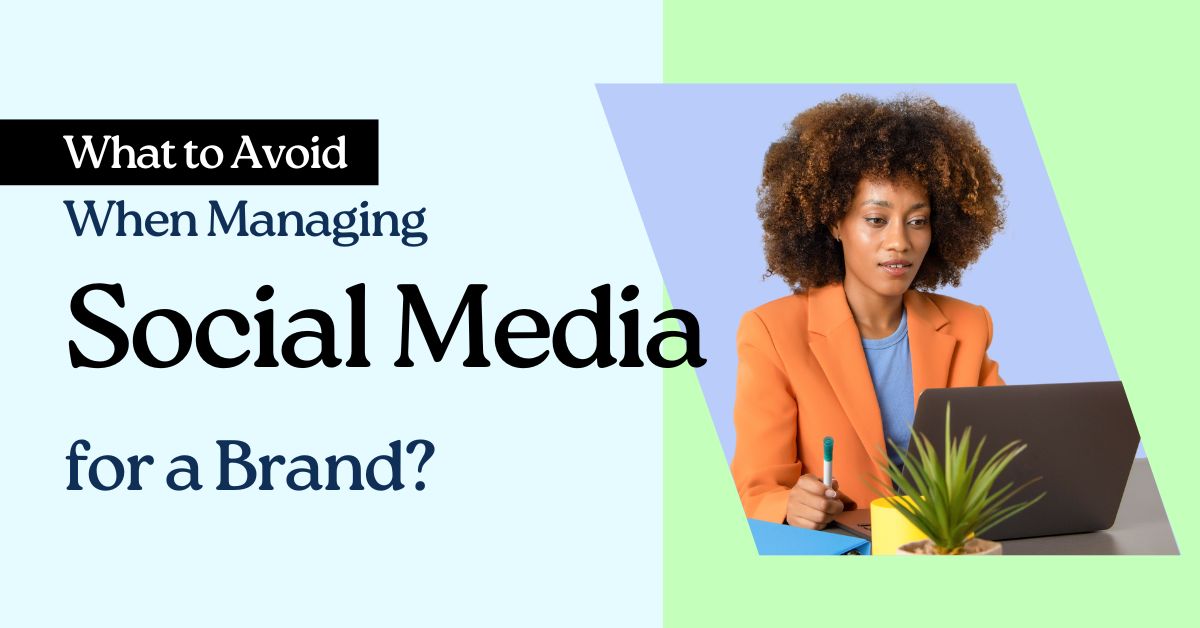What to Avoid When Managing Social Media for a Brand?
Managing social media for a brand is not just about posting pictures and writing captions. It’s about building a relationship with your audience, growing trust, and showing your brand’s true value. But while many businesses are active on social media, not all of them do it the right way. In fact, there are some common mistakes that can actually harm your brand rather than help it.
We will talk about what you should avoid when managing social media for a brand. By staying away from these mistakes, you can keep your brand looking professional, trustworthy, and engaging online.
1. Not Having a Clear Strategy
One of the biggest mistakes is not having a proper plan. Many brands just post content without thinking about what they want to achieve. Without a goal or a clear direction, your social media presence can become messy and confusing.
A good strategy includes knowing your audience, choosing the right platforms, planning what to post, and tracking your performance. Avoid jumping in without a plan.
2. Posting Inconsistently
Consistency is key in social media. If you post regularly, your audience will stay engaged. But if you post too little or too randomly, people may forget about your brand. Worse, they might think you’re not serious or professional.
Avoid long gaps between posts. Use a content calendar to plan your posts ahead of time. This helps you stay active and organized.
3. Ignoring Your Audience
Social media is not a one-way street. It’s a place for conversation. Many brands make the mistake of only talking about themselves. They don’t reply to comments or messages. This makes followers feel ignored or unimportant.
Always take time to respond to your audience. Answer their questions, like their comments, and thank them for their support. It shows that you care.
4. Trying to Be on Every Platform
Some brands think they need to be everywhere—Facebook, Instagram, Twitter, LinkedIn, TikTok, Pinterest, YouTube, and more. But this can actually hurt your efforts.
Managing too many platforms at once can be overwhelming. If you’re not active on all of them, your pages may look abandoned. Instead, focus on 2 or 3 platforms where your target audience spends the most time. Do a great job there, rather than doing a poor job everywhere.
5. Being Too Sales-Focused
Yes, social media can help you sell your products or services. But if every post is just about “Buy now!” or “Special discount!”, people will lose interest. They might even unfollow you.
Social media is about building relationships. Share useful tips, behind-the-scenes looks, fun content, and customer stories. Then, mix in your sales messages in a natural way.
6. Using Poor-Quality Content
Low-quality images, unclear videos, spelling mistakes, and messy captions can damage your brand’s image. It makes your brand look unprofessional.
Always aim for good quality in everything you post. Use clear images, check your spelling and grammar, and create eye-catching designs. You don’t need expensive tools—just take your time and make sure everything looks clean and professional.
7. Not Using Hashtags Properly
Hashtags help more people discover your content. But using too many or unrelated hashtags can look spammy. Some brands also forget to use hashtags at all.
Use relevant hashtags that connect with your post. Don’t just copy popular ones without checking their meaning. A good rule is to use 3 to 7 hashtags per post, depending on the platform.
8. Ignoring Analytics and Insights
Social media platforms give you useful data about how your posts are doing. But many brands ignore this information. They don’t check what type of content works best or what time their audience is most active.
If you want to improve, you must understand what’s working and what’s not. Track likes, shares, comments, reach, and clicks. Use that information to make better decisions.
9. Deleting Negative Comments
It’s tempting to delete bad reviews or negative comments. But doing this can make your brand look dishonest. People may feel you’re hiding something.
Instead, try to respond politely and helpfully. Show that you care about customer feedback. Even if the customer is wrong, reply with respect. This builds trust and shows professionalism.
10. Not Showing the Human Side
Some brands keep their tone too formal and cold. They forget that social media is a place for people to connect. If your posts feel robotic, people won’t feel any connection to your brand.
Show your team, share stories, celebrate wins, and use a friendly tone. This makes your brand more relatable and warm.
11. Jumping on Every Trend Without Thought
Trends can bring more attention to your brand. But if a trend doesn’t fit your brand message or values, it’s better to skip it. Forcing your way into every viral moment can look fake or desperate.
Before joining a trend, ask yourself: “Does this match our brand?” If yes, go ahead. If not, let it go.
12. Using Too Much Automation
Automation tools can save time. But if you overuse them, your account may feel lifeless. People can usually tell when a post or comment is automatic.
Try to keep a human touch. Mix automation with real-time engagement. Be present and personal where it matters.
13. Copying Other Brands
It’s okay to get inspired by other brands, but copying them completely is a mistake. Your brand should have its own voice and identity.
Build your own style, tone, and way of doing things. People will follow you because you’re original and different—not because you’re just like everyone else.
14. Not Having a Crisis Plan
Sometimes things go wrong—a wrong post, a bad customer experience, or a public mistake. If you’re not prepared, a small issue can become a big problem.
Have a plan for how to handle social media crises. Know who will respond, what tone to use, and how to fix the issue quickly.
15. Forgetting to Update Information
Outdated phone numbers, broken links, or old promotions still on your page can frustrate customers. It shows carelessness.
Make sure your bio, contact info, and links are always up to date. Review them regularly to keep things fresh.
Final Thoughts
Social media can be a powerful tool to grow your brand, but only if used correctly. Avoiding these common mistakes can save you from trouble and help you build a strong online presence.
Always remember: Social media is about people. Be consistent, be helpful, and be real. If you treat your audience with care and respect, they’ll become loyal fans of your brand.
Also Read:
- Why Hire a Social Media Manager?
- How to Manage Impersonation in Social Media?
- Top Benefits of Social Media for Business
Frequently Asked Questions
What mistakes to avoid in brand social media?
There are many mistakes brands should avoid, like posting without a plan, being inactive, ignoring followers, and focusing only on sales. These can hurt your image. It’s better to post regularly, listen to your audience, and share content that builds trust and relationships over time.
Why is it bad to post without a strategy?
Without a clear plan, your posts may confuse your audience. You won’t know what to post, when to post, or who you’re talking to. A strategy helps you stay focused, consistent, and reach the right people with the right message that fits your brand goals.
How does poor content affect a brand online?
Bad-quality photos, videos, or messy captions can make your brand look unprofessional. People may think you don’t care about your image. Good content builds trust and keeps people interested. Always aim for clean, clear, and helpful content that reflects your brand’s value and style.
Should I respond to negative comments online?
Yes, always try to respond kindly to negative comments. Deleting them can make things worse. People want to see that your brand listens and cares. Even if someone is rude, replying calmly shows maturity and helps others trust that you handle feedback in a respectful way.
Can too many platforms hurt social media work?
Yes, trying to be active on every platform can be overwhelming. You may not manage them well, which makes your brand look inactive. It’s better to focus on a few platforms where your audience is active and post high-quality content there. Quality is always better than quantity.


